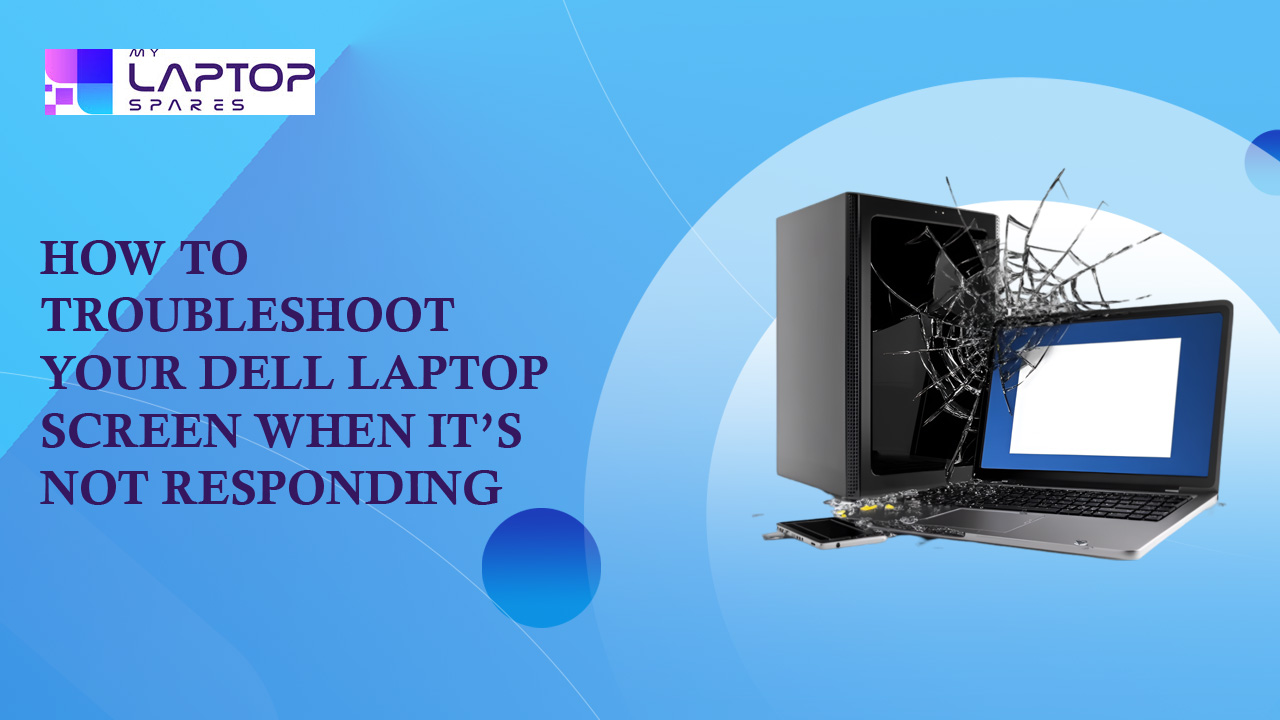How to Troubleshoot Your Dell Laptop Screen When It’s Not Responding

Check for Power Issues
Before jumping to complex troubleshooting, start by ensuring that your Dell laptop is receiving power correctly. If your laptop won’t turn on at all, the screen may not be the issue—it could be a power-related problem.Steps to check power issues:
- Ensure the charger is connected properly – Sometimes, loose connections can prevent the laptop from receiving power.
- Try a different power outlet – A faulty power source can make it seem like the laptop isn’t turning on.
- Inspect the power adapter – If you notice frayed wires or damage, consider replacing your adapter.
- Remove the battery (if applicable) – If your Dell laptop has a removable battery, take it out and plug in the power adapter directly. If the laptop turns on without the battery, the battery may need replacement.
- Perform a power drain reset – Remove the battery and unplug the power adapter. Hold the power button for 30 seconds to drain residual power. Reconnect everything and try turning it on again.
Restart Your Laptop
Restarting your laptop can resolve many temporary software glitches that may cause the screen to freeze or go black.- Hold the power button for about 10-15 seconds until the laptop turns off.
- Wait a few seconds before pressing the power button again to restart the laptop.
- If you suspect the system is frozen but still running, try pressing Ctrl + Alt + Del to bring up the Task Manager and force a restart.
Adjust the Brightness and Display Settings
If your screen appears black, the brightness settings may be turned down too low. Use the function keys (Fn + F2 or F3) to increase brightness. If the screen remains dark, connect your laptop to an external monitor to check if the issue is with the display settings or the internal screen itself. Open Windows Settings by pressing Win + I, then navigate to System > Display to adjust the brightness levels. Sometimes, external displays override brightness settings, so ensuring that the laptop is set to its internal display mode can help.Check External Displays or Connections
Connecting your Dell laptop to an external monitor can help determine whether the issue is with the screen or the laptop’s internal components.How to test with an external monitor:
- Use an HDMI, VGA, or USB-C cable to connect your laptop to an external monitor.
- Turn on the external display and check if it detects input from your laptop.
- Press Windows + P and select Duplicate or Extend to enable external display settings.
Perform a Hard Reset
A hard reset can clear temporary glitches affecting the screen.- Turn off the laptop.
- Disconnect all external devices (USB drives, printers, etc.).
- Remove the power adapter and battery.
- Hold the power button for 30 seconds.
- Reconnect the battery and power adapter, then turn the laptop back on.
Inspect the Screen for Physical Damage
Physical damage to the screen can lead to flickering, discoloration, or complete failure. Carefully examine the screen for cracks, pressure marks, or visible defects affecting its functionality. Look closely for blurry or dead pixels, which can indicate internal damage. If you notice any of these signs, your screen may require a replacement. In such cases, you can buy laptop spare parts online to find a compatible replacement screen. If your screen has cracks, flickering lines, or discoloration, physical damage may be the cause.Test Keyboard Shortcuts for Display Output
Certain keyboard shortcuts can help reset the display settings. Try:- Windows + Ctrl + Shift + B – Resets the display driver.
- Fn + F8 (or another function key depending on your model) – Switches between screen outputs.
Boot in Safe Mode to Check for Software Conflicts
Safe Mode runs the system with minimal drivers, helping diagnose software conflicts.How to boot in Safe Mode:
- Turn off your laptop.
- Turn it on and press F8 repeatedly until you see the Advanced Startup Options.
- Select Safe Mode with Networking.
Run Dell Diagnostics to Identify Hardware Issues
Dell laptops come with a built-in diagnostic tool called ePSA (Enhanced Pre-boot System Assessment) Diagnostics that helps identify potential hardware failures, including issues with the screen, motherboard, RAM, graphics card, and other components. Running these diagnostics can save time and effort by pinpointing the exact cause of your unresponsive Dell laptop screen before you consider hardware repairs or replacements.Perform a System Restore or Reset
If the issue started after a recent update, restoring Windows to an earlier point may help.How to restore your system:
- Open Advanced Startup (Shift + Restart from login screen).
- Select Troubleshoot > Advanced Options > System Restore.
- Choose a restore point and follow the prompts.
Conclusion
By following these troubleshooting steps, you can diagnose and resolve most Dell laptop screen issues without professional assistance. If you determine that a hardware component is faulty, you can buy laptop parts online from My Laptop Spares to find genuine replacement screens, batteries, and other components.Frequently asked questions
This may be due to a faulty display, outdated drivers, or a software conflict. Try an external monitor to determine if the screen or GPU is the problem.
Try updating your graphics drivers and adjusting the refresh rate in Display Settings.
Yes. If your laptop is overheating, clean the fans and use a cooling pad to prevent damage.
Visit My Laptop Spares for high-quality laptop spare parts and replacement screens.
Categories
- Accessories (83)
- Gaming Laptop (6)
- Keyboard (15)
- laptop (17)
- Laptop Adapters (15)
- Laptop Batteries (30)
- Laptop Screen (14)
- Laptop Spares (15)
- Uncategorized (1)
- video conferencing (6)
Recent Posts

Top 5 Dell Laptop Batteries for Long-Lasting Performance in 2025
In an era where digital workplaces rule and remote collaboration is the new standard, having a long-lasting and dependable read more

Keyboard Not Working on Dell Laptop? Troubleshooting + Replacement Tips
A broken keyboard on your Dell laptop can be more than just a nuisance; it can halt your entire productivity. Fortunately,... read more

How to Identify Fake Dell Laptop Batteries
In today’s technology-oriented world, our laptops are essential tools for professional tasks, learning, and leisure activities. Among the reputable laptop brands,... read more

Dell Charger Buying Guide: Wattage, Voltage & Tips
Your Dell laptop’s dependability relies heavily on the charger that powers it. Whether you’re a night owl student, a busy... read more

How Much Does a Laptop Charger Cost? Pricing by Brand & Specs
Both our personal and professional lives now depend on our computers. Your laptop charger is essential whether you're a professional... read more

Installing SSDs in Dell Laptops: Benefits and Procedures
Upgrading your Dell laptop with a Solid-State Drive (SSD) is one of the most impactful improvements you can make... read more
